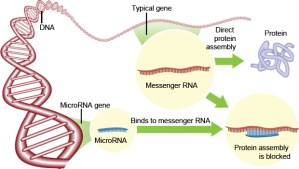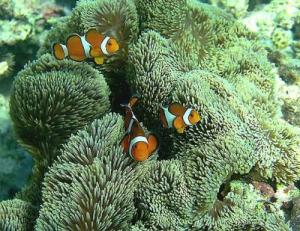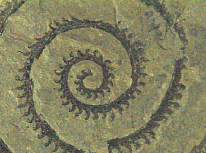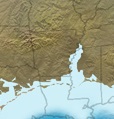Mystery Monday
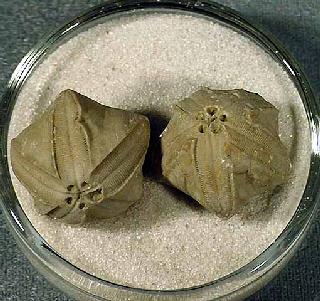
I hope you had a blast over Spring Break. Here is a fossil you might find in Northwest Arkansas. See if you can figure out what it is.
Fossil Friday, Written in Stone
On Monday, I said that the mystery fossil this week takes us back to the beginning and ties us to the present. I also said the answer was written in stone. Could you figure it out? Katharyn D. was the first to get it this week.
The picture shows a graptolite. This particular one is likely a species of Cyrtograptus. Most specimens of this type of graptolite are from Europe, they do appear in Canada and parts of the United States, including Oklahoma, according to Fossilworks.org. Did it appear in Arkansas? We don’t know. Other graptolites did, but then the book of Arkansas graptolites has not yet been written, so the true diversity of graptolites within the state is not really known.
So what are graptolites? The name means “written in stone” because they reminded people of hierogylphs or petrographs, writing or pictures scratched into stone. The first graptolites I remember seeing in the Quachita Mountains reminded me of nothing more than pencil scratches. Others, better preserved, look like saw blades or little tubes. For a long time, no one really knew what to make of them, regarding them as cnidarians, or plants, or even inorganic mineral formations. But with the advent of electron microscopy, most workers have come to the conclusion they are actually members of the group Hemichordata. This conclusion puts them at the very beginnings of all vertebrates. Vertebrates evolved from a group called urochordates, the first animals with a stiffened rod for support, an ancestral spine. Today, urochordates are tiny animals called tunicates, or sea squirts. But even before these animals evolved, there were the hemichordates, meaning “half-chordate.” They share branchial opening, or “gill slits,” a collar-like pharynx, and the beginnings of a notochord, called a stomochord. The main hemichordates alive today are called enteropneusts, or acron worms. If you go any earlier than this, you find yourself in echinoderms.

Graptolites from the Womble shale. http://www.geology.ar.gov

Graptolites from the Womble shale. http://www.geology.ar.gov
Graptolites appeared in the Cambrian Period over 500 million years ago and were thought to have died out in the Mississipian Period (Early Carboniferous), roughly 320 million years ago. They are useful as index fossils, meaning they can be used to date rocks with a fair degree of precision, because they have a worldwide distribution and are common in the rocks, as well as evolving quickly so they have many species, many of which did not last long.
 Graptolites started off growing on the ocean floor, but later ones floated freely in the ocean. When they died, they would sink to the bottom, becoming entombed in the deep ocean sediments. So today, graptolite fossils are usually found in shale formed from the deep ocean mud. Sometimes they can be found in marine limestone or chert, but they are less commonly found there. As a result, the best place to find them is in the shales of the Ouachita Mountains in west-central Arkansas. The best place to find them is in the Womble Shale, a black shale with thin limestone layers and a few small silty sandstone and chert layers. The Womble Formation was named after the town of Womble, which is now Norman, in Montgomery County, AR, so that makes that area a fine place to look. You can also find conodont fossils commonly in those rocks, which are tiny, tony, early chordates. Conodonts were the first animals in the vertebrate lineage with mineralized tissue. They had teeth, but no bone. Other places you can find them are the Arkansas Novaculite in the Ouachitas, although you will have better luck in the older rocks, such as the Mazarn or Collier Shales. You can also find them in any of the Ordovician or Silurian aged Ozark limestones in northern Arkansas, but they will be harder to find as those rocks were formed in shallower water, with many more fossils of many other animals which are far more common, whereas the graptolites will be much rarer than in the Ouachitas. For a full listing and description of the appropriate rocks and maps to their location, try the Arkansas Geological Survery website here.
Graptolites started off growing on the ocean floor, but later ones floated freely in the ocean. When they died, they would sink to the bottom, becoming entombed in the deep ocean sediments. So today, graptolite fossils are usually found in shale formed from the deep ocean mud. Sometimes they can be found in marine limestone or chert, but they are less commonly found there. As a result, the best place to find them is in the shales of the Ouachita Mountains in west-central Arkansas. The best place to find them is in the Womble Shale, a black shale with thin limestone layers and a few small silty sandstone and chert layers. The Womble Formation was named after the town of Womble, which is now Norman, in Montgomery County, AR, so that makes that area a fine place to look. You can also find conodont fossils commonly in those rocks, which are tiny, tony, early chordates. Conodonts were the first animals in the vertebrate lineage with mineralized tissue. They had teeth, but no bone. Other places you can find them are the Arkansas Novaculite in the Ouachitas, although you will have better luck in the older rocks, such as the Mazarn or Collier Shales. You can also find them in any of the Ordovician or Silurian aged Ozark limestones in northern Arkansas, but they will be harder to find as those rocks were formed in shallower water, with many more fossils of many other animals which are far more common, whereas the graptolites will be much rarer than in the Ouachitas. For a full listing and description of the appropriate rocks and maps to their location, try the Arkansas Geological Survery website here.

Cephalodiscus, a type of pterobranch. http://metazoan.auburn.edu/halanych/lab/projects.html
I mentioned that graptolites were thought to have died out in the Mississippian Period. That is because no fossils are found after this date. However, it is thought by most workers that graptolites may still be living today. We just call them pterobranchs, another type of hemichordate and are acorn worm-like animals with plant-like fronds used to filter out plankton from the water.
The Worst Headline in the World
“Sea Anemones are Half-Plant, Half-Animal, Gene Study Finds.”
Ok, maybe calling it the worst headline in the world is a little hyperbolic, but it is a terrible headline. I have seen this headline over and over again, phrased exactly the same way, indicating that many, many sites do not bother even attempting to write their own versions, but simply cut and paste from other sources. But that is not the problem I have with it. The headline is woefully incorrect, seriously misleading, and damages all the hard work educators have spent trying to get people to understand genetics and how it affects our evolutionary understanding. The people who wrote this headline should really have known better and the people who wrote the articles should certainly have known better. For an example of a well written article that really explains what the research says, yet has this horrid title to it, try here. The information in the article is excellent if one can get past the horribly misleading title. In many cases, the author of the article is not to blame because the headlines are written by completely different people, who don’t necessarily either read nor understand what the article really says. That is a serious problem because many people, if not most, only read the title, or if they read the article, only remember the spin imposed by the title. Thus, titles matter (for more information on the effects of headlines, try here, here, here, here, and here).
The headline and many of the articles imply that a new study on the genetic code of the sea anemone revealed a mixture of animal and plant DNA. The research does not in fact say that. So I will attempt here to explain what it really DID say. To summarize, the genome of the sea anemone is very similar to other animals because it is, you know, an animal. However, there are certain key aspects of its gene regulation that are similar to plants. This is not as bizarre as it might sound though.
To begin with, let’s clarify what the article is referring to. Most of the time, when people talk about genetics, they are referring to the nucleic acid sequences, specifically Deoxyribonucleic Acid, or DNA, that code for genes. This is actually only a small part of the DNA. The rest is taken up with a variety of other things, including a variety of gene regulatory elements, junk DNA (broken genes, viral sequences, etc.), and chromosome structural sequences. The genome, or total genetic sequence, collected into a set of chromosomes, can be thought of as a book. The text includes all the gene sequences, but most of it has been marked out and written over ( what is often referred to collectively as “junk DNA”). The table of contents, page numbers, chapter headings, introductory publishing information, and index would be the regulatory bits; and the spine, cover, pages themselves, and everything holding it all together would be the structural elements. All of these parts are included in the complete DNA sequence, along with various proteins like histones that help package all the DNA.
Pretty much all of this DNA in the sea anemone, according to the study, is very similar to other animals, even vertebrates like us. The genes are similar, the regulatory sequences are similar, pretty much everything is similar. This is interesting because it speaks to the relative closeness of relationships between all animals. The genes used by sea anemones are simply variations of genes found within us. The regulatory sequences are variations of the same sequences we use.
However, not everything is the same. There are small sequences called micro-RNAs. Ribonucleic acid, more commonly just called RNA, is most commonly known as the molecules that help translate DNA gene sequences into working proteins. But that is not all they can do, Unlike DNA, RNA can do more than act as a codex of information. RNA can act as an enzyme at the same time. Enzymes are typically proteins that act on other proteins or on the DNA and RNA themselves. When micro-RNAs act on the DNA and RNA, they regulate expression of the genes, altering how much and what kind of proteins are created. This is where sea anemones differ from other animals. The micro-RNA of sea anemones is more like plants than animals. It had always been supposed that plants and animals evolved their versions of micro-RNAs separately, because they use different sequences and use different molecular pathways. They act differently. For instance, in animals, micro-RNAs bind to multiple proteins and inhibit their functions. Plant micro-RNAs are much more specific and slice up the protein, they don’t just inhibit them. Thus, it may be that sea anemones are telling us that the system developed before plants and animals split off from the ancestral organisms from which both plants and animals evolved. Not only that, but that the original pattern was kept by plants and substantially altered in animals.
The other part of this story that is not made clear is just what relationship sea anemones have with other animals, as well as plants for that matter, which in this case is fairly important. When looking at the early history of eukaryotic (with a nucleus containing DNA), multicellular animals, sea anemones are really, really early. Sea anemones are part of a group called cnidarians. Cnidarians, so named for cells called nematocysts, or stinging cells, also include what are generally called jellyfish, along with coral. On the tree of animal life, you can’t get much more primitive. The only animals thought to have evolved earlier than cnidarians are sponges and ctenophores, commonly known as comb jellies. They are so close to the base of the animal tree of life, one might say if they were lower, they would be only a step away from being fungi. Fungi, according to the genetic research, branched off from the animal lineage shortly after the split between animals and plants, which indicates just how closely related these early forms are.
In addition to being really close to the the plant/animal split, there is one last thing to consider. Sea anemones, like coral, depend on a mutualistic symbiosis with green algae, which, obviously, are plants. The algae collect sunlight to make sugar and oxygen, which gets shared with the sea anemone. The sea anemone in turn provides the algae a secure home, guarded by venomous tentacles. This relationship is similar to the well-known symbiosis with clownfish (remember Finding Nemo?), in which the clownfish gets protected from predators while providing food for the anemone. This is one case in which having messy tenants is actually a good thing.
Now, considering that the anemone relies on algae for its survival, linked as it is metabolically to the algae, and evolutionarily is not that far from being a plant itself, is it any surprise then to find that some of its metabolic regulation uses a system seen in plants? Sea anemones are not half animal/ half plant. They are extremely primitive animals that have their metabolisms linked directly to a plant, unlike the indirect link that other animals have (eating plants or animals that eat plants is a strong, but indirect link, wouldn’t you say?).
Fossil Friday, Revenge of the Serpent
Mystery Monday this week fell on St. Patrick’s Day, so to celebrate, the following image was posted for the mystery fossil of the week.
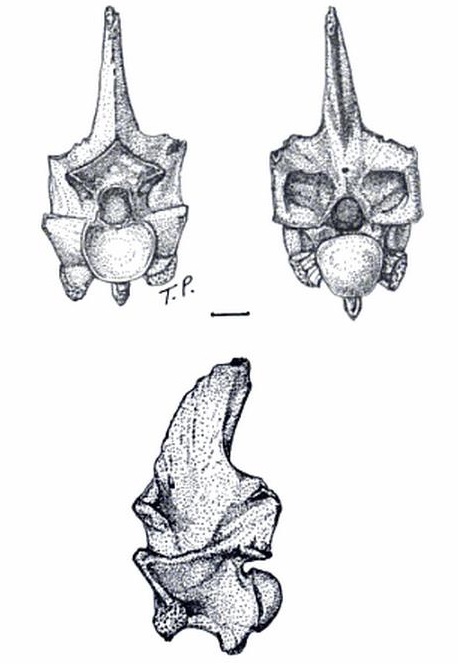 St. Patrick was well known for driving all the snakes from Ireland, at least so the myth goes. In reality, there never were any snakes in Ireland for St. Patrick to drive out in the first place. But unlike Ireland, Arkansas has always had snakes. Right now, we have a diverse population of snakes, including boasting more different types of venomous snakes than most other states, being one of only ten states that have all four types of venomous snakes in the country (there are roughly twenty separate species, but they all fall into four main groups). Here you may find the copperhead, coral snake , cottonmouth (aka water moccasin), and the rattlesnake (including the Timber, Western Diamondback, and pygmy rattlers). At least we can take comfort that we are just outside the ranges of the Massasauga and Eastern Diamondback rattlesnakes and we don’t have the diversity of rattlers seen in places like Arizona and Texas (which may win the prize for most venomous snakes in the country if both species number and diversity are taken into account).
St. Patrick was well known for driving all the snakes from Ireland, at least so the myth goes. In reality, there never were any snakes in Ireland for St. Patrick to drive out in the first place. But unlike Ireland, Arkansas has always had snakes. Right now, we have a diverse population of snakes, including boasting more different types of venomous snakes than most other states, being one of only ten states that have all four types of venomous snakes in the country (there are roughly twenty separate species, but they all fall into four main groups). Here you may find the copperhead, coral snake , cottonmouth (aka water moccasin), and the rattlesnake (including the Timber, Western Diamondback, and pygmy rattlers). At least we can take comfort that we are just outside the ranges of the Massasauga and Eastern Diamondback rattlesnakes and we don’t have the diversity of rattlers seen in places like Arizona and Texas (which may win the prize for most venomous snakes in the country if both species number and diversity are taken into account).
In the past though, we also had other snakes, including Pterosphenus schucherti, also known as the Choctaw Giant Aquatic Snake, a giant sea snake that lived here in the late Eocene roughly 35 million years ago. The Eocene was a much warmer time. In fact, this period falls at the end of what is called the Palaeocene-Eocene Thermal Maximum. There were no polar ice caps during this time, with at least double the amount of carbon dioxide and triple the amount of methane than what we see now. Because of this, Louisiana was pretty much under water and Arkansas had wonderful ocean front property, along with a lot of swamps and marshes. It is likely the cooling during this period into the Oligocene Period, that caused the extinction event that wiped out these snakes, along with several terrestrial mammals, including a variety of Perissodactyl horse ancestors, artiodactyls (cloven hoffed mammals), rodents, and primates.

Pterosphenus model at the Florida Museum of Natural History. It is too wide, though, as noted by the staff of the VMNH paleontology lab, who took this picture.
This was the perfect environment for a number of different snakes, although we don’t have fossil evidence of many. One that we do have is of Pterosphenus. This snake had tall, narrow vertebrae, indicating adaptation to an aquatic lifestyle. In fact, it probably was not able to support itself on land very well due to its thin body.
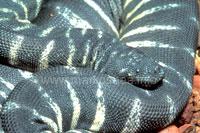
Little file snake, Acrochordus granulatus. http://www.markshea.info
Sea snakes today rate as some of the most highly venomous snakes in the world. However, there are nonvenomous ones as well, such as the marine file snake, Acrochordus granulatus, which live in coastal regions between Asia and Australia. Those of today are relatively small snakes, ranging from half a meter to just over 2 meters (2 feet to 7 feet or so). Pterosphenus, on the other hand, reached lengths of 2.3 m to 5.1 m, or possibly larger.
Unfortunately, we don’t know a whole lot about these snakes, other than they were clearly aquatic. The bones that have been found with them, such as whale bones, have indicated marine waters. Fossils of these snakes have been found in eastern Arkansas, in Saint Francis County in the Eocene deposits around Crow Creek called the Jackson Group.
Mystery Monday, St. Patrick’s Day ed.

Happy St. Patrick’s Day! In honor of the day, today’s Mystery Monday fossil is related to the legend of St. Patrick. You can probably easily notice it is not a fossil shamrock, which has never been found in Arkansas, unlike the previous owner of this fossil. Finding a 4-leaf clover is generally considered lucky, you probably wouldn’t think the same thing if you found one of these alive. I could find no pictures of the actual fossil and I don’t have access to it, so I hope you will forgive me for using an illustration from the paper that described it.
Fossil Friday, make it a Productive one
Were you able to solve Monday’s mystery fossil? They aren’t little poop balls, nor are they clams, although they are often mistaken for them.
This photo can be found at the Arkansas Geological Survey website under “Brachiopod.” They look a lot like clams. Brachiopods, often called lamp shells, have two shells and live in shallow marine environments just like clams and the occupy the same niche, feeding on organics filtered from the water. But unlike clams, which are molluscs, just like snails and squid, brachiopods are lophophorates, most closely related to bryozoans, the “moss animals.”.

Bryozoan lophophore. http://www.geol.umd.edu/
So what is a lophophorate? Lophophorate means “crest or tuft bearer, so named for their feeding apparatus called a lophophore, which is shaped like a roughly circular or semi-circular ring of tentacles. These tentacles lazily wave through the water passing through the lophophore, catching small particles of food suspended in the currents. Thus, everything in this group are what is known as suspension feeders. These lophophores serve not only to collect food, but for gas exchange as well. In addition, the animals are headless, with the lophophore surrounding the mouth. The food enters the mouth and passes through the digestive tract, which makes a U-turn and dumps out what it can’t digest just outside the ring of tentacles. Clams do essentially the same thing, only they use an entirely different apparatus to do so.
Clams attach themselves to surfaces by secreting a collection of what are called byssal threads. Most brachiopods, on the other hand, form a pedicle, a stalk that holds them in place. Some do not make pedicles, instead just gluing themselves down directly onto the rock.

Symmetry in a brachiopod and clam. http://www.kgs.ku.edu
Another difference that can usually be seen between clams and brachiopods is the symmetry of their shells. Brachiopods are symmetrical from side to side, their left side is the same as their right side. Clams follow a different pattern. They usually have two identical shells, but the shells themselves are not symmetrical. This is not always true though. The Cretaceous oyster, Exogyra ponderosa, has an huge, thick shell on one side and a thin lid for a shell on the other. But as a general rule, this usually works. Another difference that is sometimes stated is that brachiopods use their muscles to close their shells, while clams use their muscles to open their shells, closing them by the use of ligaments; thus making brachiopods more susceptible to predators. This, however, is not true. In truth, brachiopods use their muscles to both open and close their shells. Clams have large adductor muscles that function to close the shells and they have ligaments that open them when the muscles relax.
 Brachiopods are quite diverse, with many different types. They range in size from less than a dime to almost 40 cm (15″). There are two general groups, the Articulates, which have toothed hinges holding the shells together, and the Inarticulates, which do not have teeth, so they fall apart easily after death. Probably the most commonly found in Arkansas are spirifers, known for being somewhat wing-shaped , with a prominent sulcus, or depression in the center. Many brachiopods prefer solid substrates, like rock, others were adapted for softer substrates like sand or mud.
Brachiopods are quite diverse, with many different types. They range in size from less than a dime to almost 40 cm (15″). There are two general groups, the Articulates, which have toothed hinges holding the shells together, and the Inarticulates, which do not have teeth, so they fall apart easily after death. Probably the most commonly found in Arkansas are spirifers, known for being somewhat wing-shaped , with a prominent sulcus, or depression in the center. Many brachiopods prefer solid substrates, like rock, others were adapted for softer substrates like sand or mud.  Productids, like the ones in our mystery fossil, often grew spines, which helped secure them to muddy surfaces. Others, like strophomenid brachiopods, handled muddy substrates by developing large, very flat shells, which floated on the mud like a snowshoe.
Productids, like the ones in our mystery fossil, often grew spines, which helped secure them to muddy surfaces. Others, like strophomenid brachiopods, handled muddy substrates by developing large, very flat shells, which floated on the mud like a snowshoe.  Still others, like the modern-day lingulids, developed long pedicles, allowing them to burrow down into the sediment.
Still others, like the modern-day lingulids, developed long pedicles, allowing them to burrow down into the sediment.
Brachiopods have been around since at least the Cambrian, over 520 million years ago. They were most abundant in the Paleozoic Era, but suffered greatly during the Permo-triassic extinction event. They recovered to some extent, but never reached their previous abundance due to the appearance of clams, which began taking over some of the spaces they occupied. Nevertheless, there are still several different kinds in the modern ocean and can often be seen clinging to rocks near shore or buried in the sand. In Arkansas, you won’t find any living specimens, but you can find numerous fossil brachiopods in the Paleozoic rocks throughout the Ozarks and Boston Mountains, even in some places of the Arkansas Valley. Stop by any outcrop along Highway 65 between Conway and the north edge of the state, particularly limestone outcrops, and you are likely to find some. You can find a few in the Bigfork Chert in the Ouachitas, but they are not nearly so common as they are farther north.
Mystery Monday
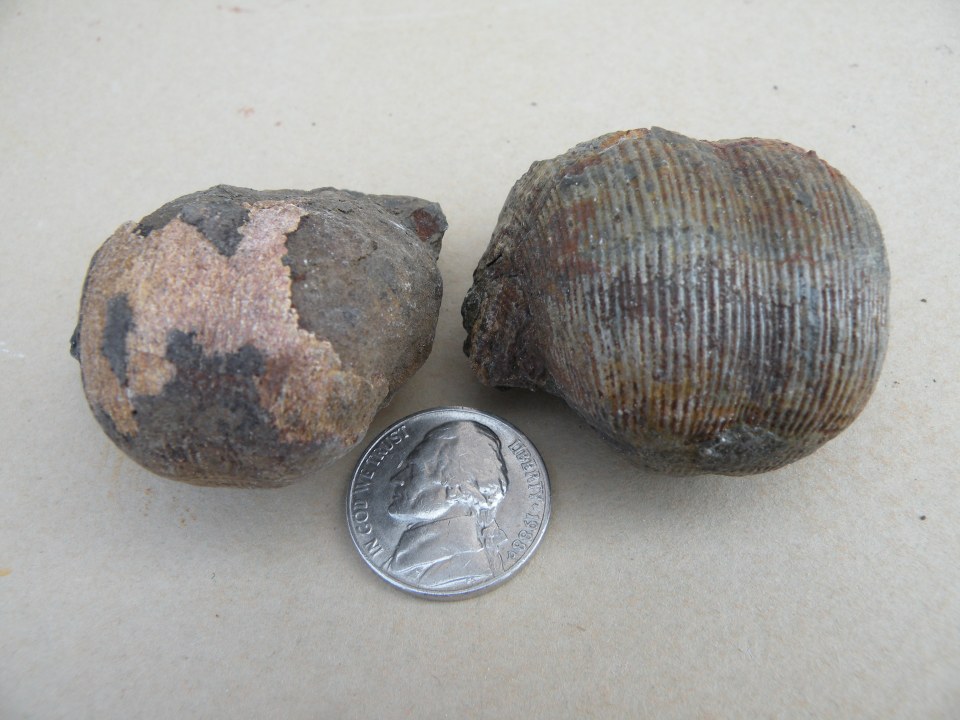
It’s Monday! Time for a new mystery fossil. See if you can guess what this is. Don’t clam up, put your guess in the comments below.
Fossil Friday, don’t be a wet blanket
Despite the snow, we didn’t get a chance to have any other posts this week other than the Monday Mystery fossil. We did, however, have three different school trips in the past couple of weeks to talk to kids about fossils, dinosaurs, and the skeletal system, as well as giving talks on the fossils telling us about the origins of crocodiles and dinosaurs, as well as attending a talk on the origins of birds. So a lot of paleo work, just not much showing up here. Fortunately, some of you had some time to examine our mystery fossil and congratulations to Laurenwritesscience for coming up with the correct answer.
It is indeed a stromatolite. Bruce Stinchcomb has a video on Youtube showing several examples of Ozark stromatolites and providing a good explanation of what they are.
Essentially, stromatolites are microbial ecosystems, built up of layer after layer of microbial mats. The general description is that of blue-green algae, which forms a sticky layer over the surface of a rocky surface in a shallow marine or coastal environment. Blue-green algae are not actually algae and are better referred to as cyanobacteria. These bacteria are photosynthetic, just like plants, so they need sunlight, thus limiting the depth at which they can be found. Actually, they are typically found right at the water’s edge in the tidal zone. This sticky substance, while maintaining their hold on the rock, also tends to collect sand, clay, and organic debris. Over time, all the stuff that sticks to the mat blocks the sunlight from the cyanobacteria and they migrate above the layer and build another mat, which collects more debris, which causes them to build another mat, etc. Stromatolites form much the same way as piles of laundry. By the time you finish washing one set, there is another pile forming in a neverending stream. The life of a cyanobacteria in a stromatolite is a depressing condition of always digging themselves out from under a pile just to get dumped on again. I am sure most people can empathize.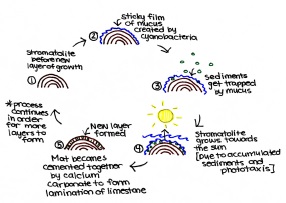
The sticky mucus (properly referred to as extrapolymeric substance, or EPS for short, but we can go with mucus here) forming the mat does more than just cause things to stick to it. The mat protects the bacteria in from ultraviolet radiation. It also allows the bacteria to control the microenvironment around them, keeping such things as pH levels in a good range. It also has an unfortunate aspect for the bacteria. The mucus allows the levels of calcium and carbonate ions to build up until they precipitate out of the water as calcium carbonate, also known as calcite (when referring to the mineral), or limestone (when referring to the rock). So not only are the poor bacteria constantly getting buried, they are getting turned to stone in their very own medusa nightmare. Life is hard as a cyanobacteria. But just wait, it gets worse.
 These microbial mats are not just cyanobacteria, though. There are lots of other organisms that live in and on them. There are many other types of bacteria. There are sulfate reducing bacteria, which use sulfur like we use oxygen, only they release hydrogen sulfide instead of carbon dioxide, causing a nice rotten egg smell. There are purple sulfur bacteria that eat the hydrogen sulfide, as well as colorless sulfur bacteria that eat both the hydrogen sulfide and the oxygen released by the cyanobacteria, thus free-loading off of everyone. In addition to bacteria, there are plenty of prokaryotes (organisms without nuclei that holds their DNA) and eukaryotic (with nuclei) single-celled and multi-celled organisms living in the mat. Diatoms, single-celled photosynthetic organisms that grow their own shell, live on top, while nematodes burrow through the mat. In addition to all this, a wide variety of animals love to chow down on the mats. Everything from snails, sea urchins, crabs, crawfish, and just regular old fish happily eat them. As a result, there are not a lot of places left in the world you can find stromatolites growing. The Bahamas and Shark’s Bay, Australia are the best areas to find them.
These microbial mats are not just cyanobacteria, though. There are lots of other organisms that live in and on them. There are many other types of bacteria. There are sulfate reducing bacteria, which use sulfur like we use oxygen, only they release hydrogen sulfide instead of carbon dioxide, causing a nice rotten egg smell. There are purple sulfur bacteria that eat the hydrogen sulfide, as well as colorless sulfur bacteria that eat both the hydrogen sulfide and the oxygen released by the cyanobacteria, thus free-loading off of everyone. In addition to bacteria, there are plenty of prokaryotes (organisms without nuclei that holds their DNA) and eukaryotic (with nuclei) single-celled and multi-celled organisms living in the mat. Diatoms, single-celled photosynthetic organisms that grow their own shell, live on top, while nematodes burrow through the mat. In addition to all this, a wide variety of animals love to chow down on the mats. Everything from snails, sea urchins, crabs, crawfish, and just regular old fish happily eat them. As a result, there are not a lot of places left in the world you can find stromatolites growing. The Bahamas and Shark’s Bay, Australia are the best areas to find them.
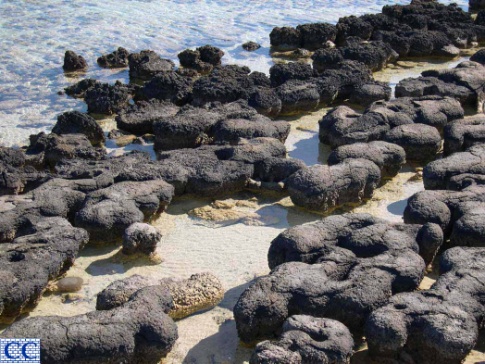 They may be rare now, but at one time, they ruled the earth. As some of the oldest living communities in the world, they have been around for at least 3.5 billion years (that’s 3,500,000,000, or roughly 600,000 times the length of human civilization) and for more 2/3 of that time, they were the only game in town and in all probability served as the cradle for all eukaryotic and multi-cellular organism on the planet. These days, if you live in Arkansas, the only places you can find them are as fossils in the Cambrian age Cotter Formation and Ordovician age Everton Formation in the Ozark Plateau.
They may be rare now, but at one time, they ruled the earth. As some of the oldest living communities in the world, they have been around for at least 3.5 billion years (that’s 3,500,000,000, or roughly 600,000 times the length of human civilization) and for more 2/3 of that time, they were the only game in town and in all probability served as the cradle for all eukaryotic and multi-cellular organism on the planet. These days, if you live in Arkansas, the only places you can find them are as fossils in the Cambrian age Cotter Formation and Ordovician age Everton Formation in the Ozark Plateau.
For further information (and the source of the images shown here), check out the stromatolite page at the Arkansas Geological Survey and the Microbe Wiki stromatolite page, as well as the Microbes.arc.nasa.gov site, which supplies a nice teacher’s guide to teaching all about microbial mats, designed for grades 5-8.
Mystery Monday, another snow time edition
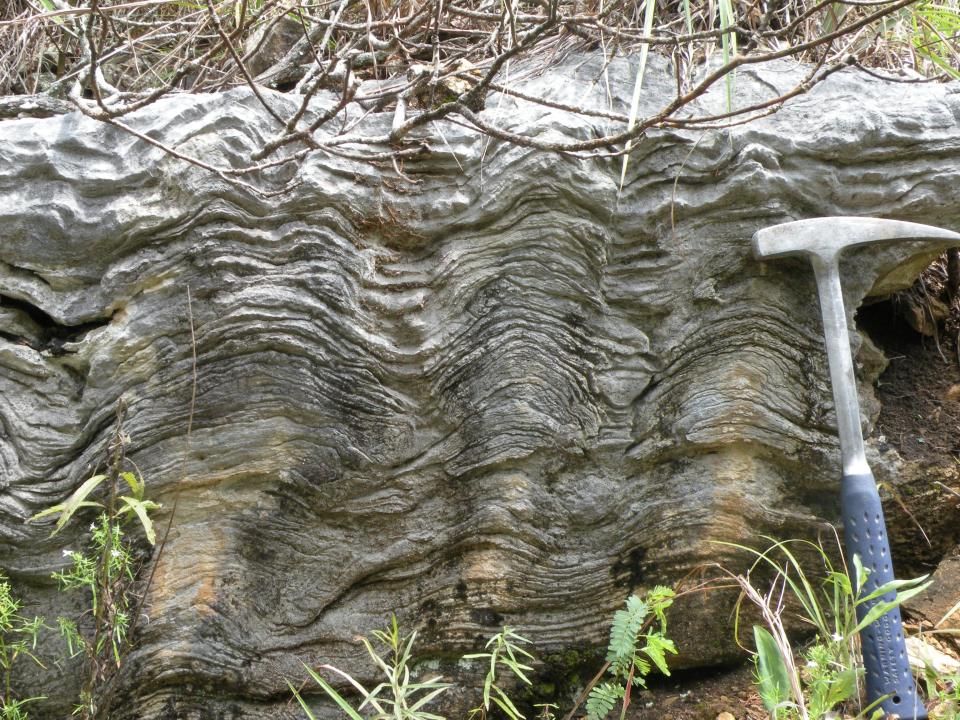
I don’t know where you may be, but where I am, ice is covering everything and all the schools are closed. It’s a great day to pull up the covers and stay under the blankets, maybe get a cup of hot chocolate and wait for warmer weather. That makes today’s Mystery Monday fossil particularly apropos. Yes, this really is a fossil, not just layers of sediment.





